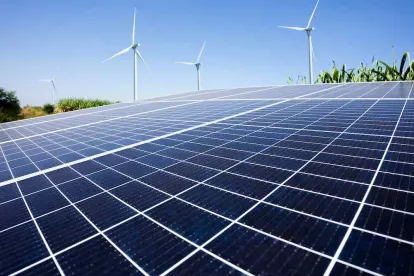On December 27, 2020, President Trump signed H.R. 133, the “Consolidated Appropriations Act, 2021,” an agglomeration of dozens of individual pieces of legislation which together total nearly 6,000 pages. While general press coverage has mostly focused on the controversy concerning the size of relief checks that will be sent to most taxpayers, and on appropriations to prevent a federal government shutdown, the Act contains substantial, and potentially historic, provisions addressing energy, climate change, and sustainability. The Act helps lay the groundwork for what promises to be a major push towards renewable energy sources and reductions in greenhouse gases (GHGs). These developments create a tremendous opportunity for renewable energy and GHG reduction projects, but also create new compliance burdens across a variety of industries.
Summary and Key Takeaways of the Environmental and Energy Provisions of the Act
The Act places the spotlight on confronting climate change through a variety of measures including energy-related tax incentives, regulation of facilities and energy production, methods to reduce GHG emissions, and research and development initiatives.
Energy-Related Tax Incentives
-
Solar Investment Tax Credits (ITCs). The Act extends the current 26% solar ITC for solar photovoltaic and solar water heating projects beginning construction between January 1, 2020 and December 31, 2022. This steps down to 22% for projects beginning construction between January 1, 2022 and December 31, 2023, and 10% for commercial solar projects beginning construction in 2024 and placed in service after December 31, 2025. This credit also potentially extends the solar project completion deadline to January 1, 2026 where a project started under the “safe harbor” provisions. Fiber optic solar, fuel cells, and small wind energy properties follow the same phase-out scheme with the exception of the 10% ITC where there is 0% ITC where construction begins in 2024 or where service begins after 2025. Microturbines and combined heat and power systems also maintain a 26% ITC for projects beginning between January 1, 2020 and December 31, 2022, but the ITC drops to 10% if construction begins before 2024 and 0% for construction thereafter.
-
Wind Production Tax Credits (PTCs). Current law gives wind facility owners PTCs for the first 10 years of service where construction began before the end of 2020 and service starts by 2024. The Act extends PTC eligibility by one year for projects that began construction in 2021 or earlier at the current 60% level.
-
Offshore Wind ITCs. The Act also encourages offshore wind development and production by cementing a 30% offshore wind ITC for projects beginning construction by January 1, 2026 in coastal and navigable waters of the United States.
-
Coal on Tribal Lands PTC. While most of the Act’s tax incentives focuses on renewables, it also includes an extension from 15 years to 16 years for the PTC for coal mined on tribal lands.
-
Fuel and Vehicle Tax Credits. The Act extends the following tax credits, which provide businesses and individuals with continued incentives to support renewable and alternative technologies:
-
The alternative fuels outlay payment/excise tax credit under Internal Revenue Code (IRC) Section 6427(e)(6)(C) to December 31, 2021 for alternative fuels sold or used after December 31, 2020;
-
The second generation biofuel producer credit under IRC Section 40(B)(6)(J) to January 1, 2022 for qualified second generation biofuel production after December 31, 2020;
-
The alternative fuel refueling property credit under IRC Section 30C(g) to December 31, 2021 for properties placed in service after December 31, 2020;
-
The qualified fuel cell motor vehicle tax credit under IRC Section 30B(k)(1) which includes hydrogen fueled vehicles to December 31, 2021 for property purchased after December 31, 2020; and
-
The 2-wheeled plug-in electric vehicle credit under IRC Section 30D(g)(3)(E)(ii) for electric scooters and motorcycles to January 1, 2022 for vehicles acquired after December 31, 2021.
-
-
Carbon Capture Storage Tax Credit. Carbon capture storage technology allows for industrial power plants and facilities to contain their carbon emissions in the saline rock formations for hundreds of years. IRC Section 45Q provides a tax credit for carbon capture, utilization, and storage. The Act allows more time to qualify for the carbon capture tax credit by extending the construction commencement qualification date for the credit to December 31, 2025.
-
Commercial Energy Efficiency Deduction. The Act makes the commercial energy efficiency deduction under IRC Section 179D permanent and provides an annual cost of living adjustment. This tax incentive falls in line with the long-term prioritization of building energy conservation.
Facilities and Energy Production
-
Permitting, Price and Goals for Renewable Energy on Federal Land. Division Z of the Act (Energy Act of 2020) establishes a mechanism to coordinate permitting of renewable energy projects on federal lands and directs the relevant federal agencies to consider reducing rental or royalty rates if federal rates are above market or discourage the development of specific resources. The Act also requires the Secretary of the Interior to establish national goals for renewable energy production on federal land by September 1, 2022, and to issue permits allowing development of at least 25 gigawatts if electricity from wind, solar, and geothermal energy projects on federal lands by 2025. The Act calls for the creation of a national Renewable Energy Coordination Office to work with State, district, or field offices to establish and implement a program to improve federal permit coordination with respect to wind, solar, and geothermal projects on permissible federal land. In addition, where drilling is already occurring on an oil and gas lease issued under the Mineral Leasing Act, geothermal energy can be co-produced through noncompetitive leasing by the holder of an oil and gas lease.
-
Building Energy Conservation. The Energy Act of 2020 portion of the law establishes or expands energy conservation programs aimed at, for example, data centers, schools, and federal buildings. It expands support for low-income weatherization programs, water conservation, and rebate programs for certain energy-efficient equipment. It encourages “smart” buildings, establishes a program to help building-level demand response and energy management programs, and provides technical support for combined heat and power systems. The Act also establishes a new pilot program to support innovative or advanced energy- or water-saving technologies at water and wastewater utilities.
-
Liquefied Natural Gas (LNG) Facilities Standards Updates. Within 3 years of enacting this Act, the Secretary is required to review and update the minimum operating and maintenance standards for LNG facilities in order to ensure such facilities are safe and that hazards are reduced. This provision likely seeks to mitigate issues with LNG facilities related to dangerous methane leaks. The Act requires the Secretary to promulgate regulations for leak detection and repair programs for certain types of pipelines, gathering lines, and gas distribution facilities for safety and the protection of the environment. The Act also requires inspection and maintenance plans among other requirements in its endeavors to increase safety related to LNG production, storage, and distribution.
GHG Reduction Methods
-
Carbon Removal Program. The Act establishes a carbon removal program headed by various agencies, including the Secretary of Agriculture, which will perform research, development and demonstration to test, validate, or improve technologies and strategies to remove carbon dioxide from the atmosphere on a large scale. The program will begin with $175,000,000 in appropriations in 2021 and look at removal methods including carbon capture and storage technology, bioenergy, geological weathering, agricultural practices, forest management, afforestation, and carbon sinks. The program must also create and administer an innovation prize to encourage research and development. The Act also tasks the Secretary of Energy to provide a report within 180 days of enactment that analyzes how much carbon removal is required by 2050 to achieve net-zero emissions and stabilize the climate.
-
Diesel Engine Emissions. The Act reauthorizes the EPA’s Diesel Emissions Reduction Act (DERA) Program with appropriations of $100,000,000 each year through 2024. The Program curbs diesel engine emissions by financing grants, loans, and rebates for projects to replace older “legacy” diesel engines with cleaner-running engines.
-
Phase-down of HFCs. The American Innovation and Manufacturing Act of 2020 (AIM Act) section of the new law directs EPA to establish a regulatory framework for phasing down the production and consumption of hydrofluorocarbons (HFCs) – a category of highly potent GHGs – over a fifteen year period, consistent with the Kigali Amendment to the Montreal Protocol, which the U.S. has yet to ratify. Other key provisions of the AIM Act resurrect EPA’s authority to regulate the use of HFCs in various end-uses under the EPA’s Significant New Alternatives Policy (SNAP) program, and require EPA to promulgate regulations minimizing the likelihood of releases of HFCs from equipment that is serviced, repaired, or disposed. The SNAP-related authorization targets the D.C. Circuit’s Mexichem decision in 2017 asserting that EPA’s statutory authority to restrict the use of HFCs under the SNAP program was limited to manufacturers that had not yet replaced ozone depleting substances with HFCs, considerably limiting the scope of SNAP Rules 20 and 21 and making even the narrowed scope of those rules challenging to enforce as a practical matter. Meanwhile, the requirement to promulgate regulations minimizing the release of HFCs undermines EPA’s final rule in March of this year rescinding a number of refrigerant management regulations in 40 C.F.R. Part 82, Subpart F as applied to HFCs, a rule which is currently being challenged by environmental groups. Entities manufacturing or using products containing HFCs should begin evaluating the impact of the AIM Act on their operations and prepare to engage in several EPA rulemakings in 2021 and beyond. These include rules that will regulate the phase-out of HFCs by prescribing allowances for various purposes, rules that will restrict or prohibit the use of HFCs in various end-uses under EPA’s SNAP program, and rules that will revive the applicability of certain refrigerant management regulations to equipment containing HFCs. Watch for an upcoming news alert with more detailed information regarding the implications of the AIM Act for the regulation of HFCs.
Research and Development
-
Energy Research and Development: The Energy Act of 2020 provides support for research, development, demonstration, and commercialization of a variety of low and zero-emission technologies. The Act also includes support for a major research program on large-scale removal of carbon from the atmosphere. In addition, it provides for a new research and demonstration initiative aimed at encouraging advanced “smart grid” technologies and for integrating electric vehicles and other end-users into grid management technologies. This program will include research on microgrid and distribution grid technologies, as well as technologies that improve the operation of high-voltage transmission systems.
-
Rare Earth Elements Research and Development. The Energy Act of 2020 also creates a new Department of Energy research program aimed at developing new technologies for the extraction of and recovery of rare earth metals and for mitigating the health and environmental impacts arising from the recovery of such elements. Rare earth elements such as lithium are critical for new battery technologies that will be in great demand with expanded use of, for example, electric vehicles, and this element of the Act will help ensure that supply chains for these elements are secure.
-
Net Metering Study. The Act directs the Department of Energy to contract with the National Academy of Sciences to undertake a two-year study of net metering. This provision is significant because net metering has in recent years been a matter of considerable controversy in a number of states where utilities and some consumer advocates claim that net metering rates have imposed on unjustifiably burden on customers who do not own net-metered renewable energy systems.
-
Carbon Capture and Utilization. The “Utilizing Significant Emissions with Innovative Technologies Act” (USE IT Act) amends the Clean Air Act in an effort to advance carbon capture and utilization. The provisions direct EPA to develop a new direct air capture technology board, establish a research competition for direct air capture and carbon utilization research, and take various other steps to help advance carbon dioxide capture and utilization projects and related research.
The “Consolidated Appropriations Act, 2021” is one of the largest pieces of legislation in U.S. history to date. Numerous provisions in the Act provide opportunities and advancement for the United States to move forward in the fight against climate change, including a number of energy and sustainability measures.








 />i
/>i

